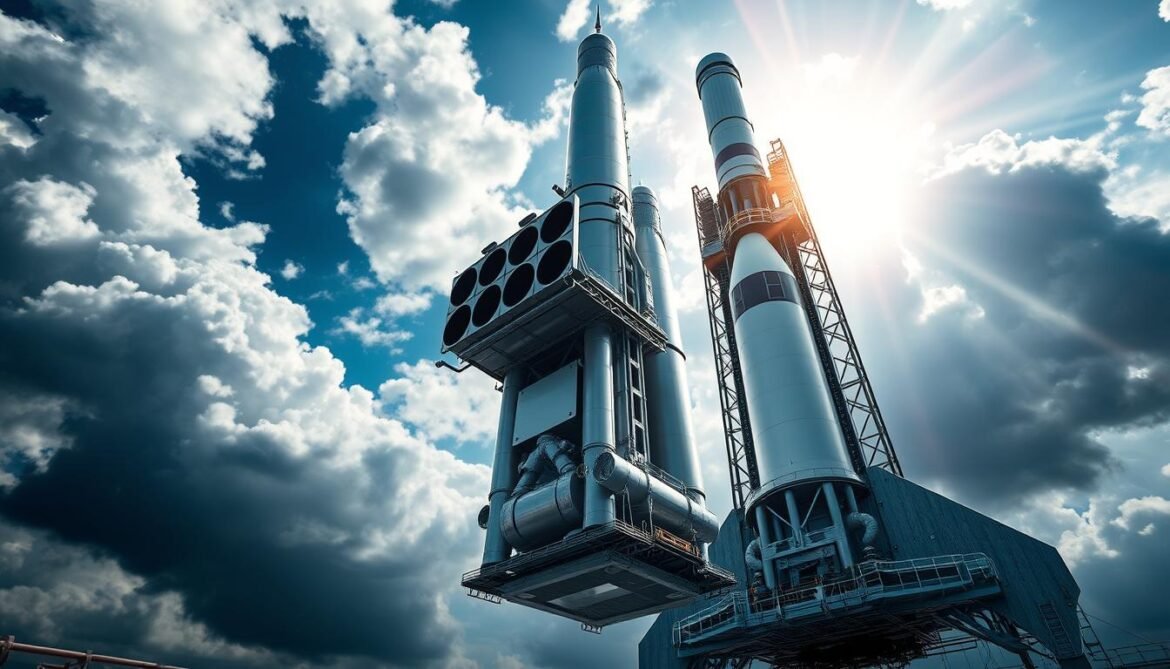A rocket represents one of humanity’s most remarkable engineering achievements. These vehicles propel themselves using jet propulsion, operating independently of surrounding air. This unique capability makes them perfect for space exploration.
At its core, a rocket functions as a pressurized chamber containing gas. A small opening allows this gas to escape at high speed. According to Newton’s Third Law, this creates thrust in the opposite direction.
The fundamental science behind these incredible machines dates back centuries. Sir Isaac Newton’s 1687 publication, the Principia, described the physical principles governing motion. His laws form the foundation for understanding how modern rockets operate.
Modern rockets actually perform more efficiently in the vacuum of space than within Earth’s atmosphere. Chemical propulsion remains the most common method today. Fuel combines with an oxidizer to create high-speed exhaust through combustion.
This basic principle has enabled humanity’s journey beyond our planet. From early experiments to today’s massive launch vehicles, the same fundamental science continues to propel us forward.
Introduction to Rocket Science
The development of rocket technology stands as a pivotal moment in human history, unlocking access to the cosmos. This field of science transformed our relationship with the universe around us.
Understanding the Importance of Rocketry
Rocketry became the enabling technology for the Space Age during the 20th century. Historic achievements like lunar landings demonstrated the power of these propulsion systems.
Modern rockets remain the only method for launching spacecraft into orbit. They achieve the incredible velocity required to overcome Earth’s gravitational pull.
The Role of Rockets in Space Exploration
Multistage rockets can attain escape velocity—over 40,250 km per hour. This allows spacecraft to travel beyond Earth’s influence into deep space.
Once in orbit, these vehicles become artificial satellites serving commercial and scientific purposes. The continued advancement of rocket science ensures humanity’s ongoing exploration of the final frontier.
Rocket technology represents humanity’s bridge between terrestrial existence and cosmic exploration.
The pursuit of space exploration depends entirely on mastering these powerful propulsion systems. From communication satellites to interplanetary missions, rockets continue to expand our presence beyond Earth.
A Step-by-Step Guide on How Rockets Work
At the heart of every space vehicle lies an elegant physical phenomenon. This principle governs all propulsion systems from simple toys to complex launch vehicles.
Basic Rocket Principles
A rocket functions as a sealed chamber containing pressurized gas. When this gas escapes through a small opening, it creates movement.
Think of a common balloon. The compressed air inside seeks escape. When released, the balloon flies in the opposite direction from the escaping air.
This demonstrates the same fundamental concept. The escaping gas generates thrust that pushes the vehicle forward.
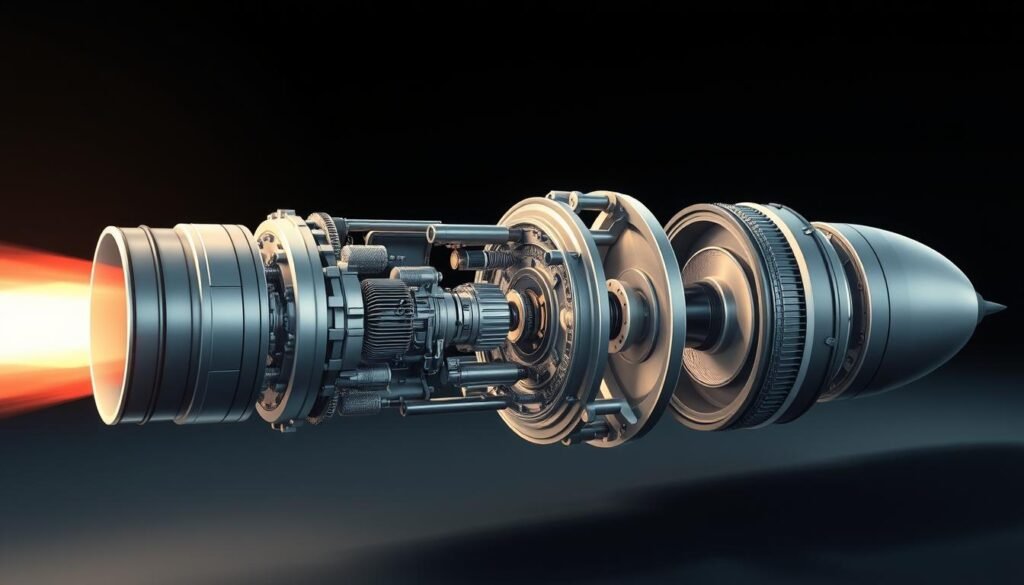
From Propellant to Thrust
Space vehicles differ in how they create pressure. Instead of simple compression, they burn propellant materials.
The propellant combines fuel with an oxidizer in the combustion chamber. This chemical reaction produces high-pressure gas.
A specially designed nozzle controls the gas escape. This focused exit converts energy into powerful thrust.
The rocket propulsion process remains consistent across designs. Whether simple or complex, the basic principle of action and reaction applies.
Newton’s Laws: The Foundation of Rocketry
Modern space exploration stands firmly on scientific principles established centuries ago. Sir Isaac Newton’s 1687 Philosophiae Naturalis Principia Mathematica described three fundamental laws governing all motion. These principles provide the complete scientific framework for understanding rocket propulsion.
Newton’s First Law and Its Impact
Newton’s First Law of Motion states that objects at rest remain at rest unless acted upon by an unbalanced force. This principle of inertia explains why rockets cannot simply begin moving on their own.
On the launch pad, balanced forces keep the vehicle stationary. The pad pushes upward while gravity pulls downward. Only when engines ignite does an unbalanced force overcome this equilibrium.
Newton’s Third Law: Action and Reaction
The Third Law provides the propulsion mechanism: for every action there is an equal opposite reaction. This law explains how rockets generate thrust in any environment.
When a vehicle expels gas downward (action), the gas pushes upward on the engine (reaction). This equal opposite force propels the craft forward. The principle works equally well in atmosphere or vacuum.
Space vehicles push against their own expelled material rather than external air. This understanding enabled designers to create powerful launch systems capable of reaching orbit.
The Mechanics Behind Rocket Engines
Inside every modern launch vehicle, sophisticated engines transform chemical energy into powerful propulsion. These systems convert stored propellant into high-speed exhaust that generates thrust.
Chemical Propulsion and Combustion
Chemical rocket engine systems dominate modern space technology. They combine fuel with an oxidizer in a combustion chamber.
The resulting chemical reaction produces intense heat and high-pressure gas. This combustion process creates expanding gases that accelerate through a nozzle.
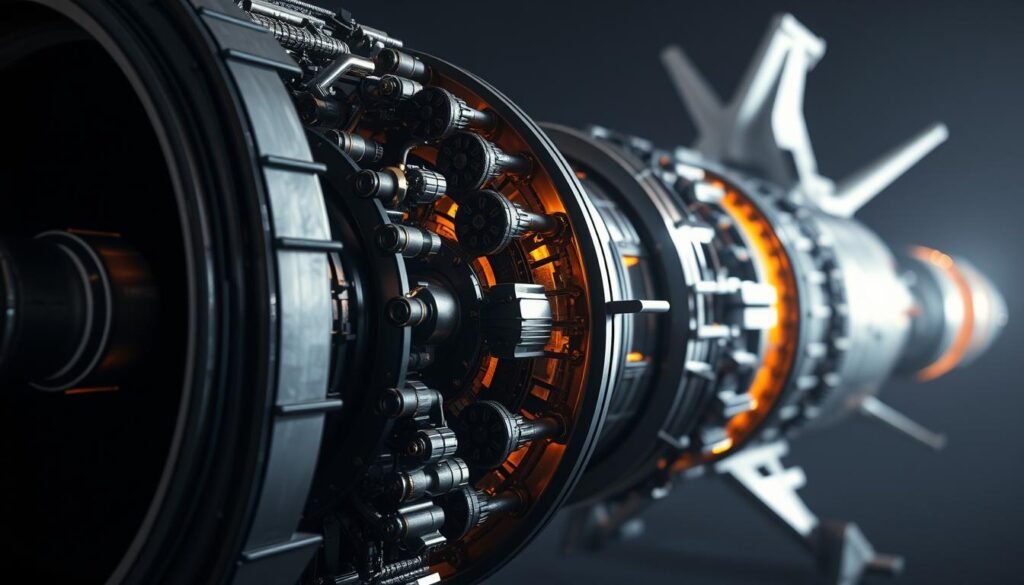
Different propellants offer unique advantages. Monopropellants use catalysts for decomposition. Hypergolic propellants ignite spontaneously on contact.
Traditional combinations like kerosene with liquid oxygen require ignition. Each fuel system serves specific mission requirements.
Alternative Engine Technologies
Robert Goddard’s 1926 breakthrough revolutionized engine design. His supersonic nozzle attached to a high-pressure chamber dramatically improved efficiency.
This innovation increased thrust and raised engine performance from 2% to 64%. It established modern rocket engine principles.
Other technologies include nuclear thermal and solar thermal systems. These alternative engines provide different propulsion solutions.
All rocket engine designs share the same fundamental principle. They accelerate gas to high speed through nozzles to create thrust.
Design and Components of Rockets
Every successful launch depends on carefully engineered components that form the complete rocket system. These vehicles integrate structural, propulsion, and guidance elements into a cohesive unit. The design balances multiple competing requirements for optimal performance.
Structural Elements and Fairings
A strong monocoque frame holds all rocket components together. This structural backbone must withstand intense launch forces. Aerodynamic fairings, like nose cones, reduce atmospheric drag during ascent.
Stabilization devices ensure controlled flight. Fins provide passive stability in atmosphere. Vernier engines and gimbaled main engines allow precise thrust vectoring. Gyroscopes detect orientation changes for navigation systems.
Nozzles, Propellant Tanks, and Chambers
The combustion chamber contains the burning propellant mixture. High-pressure gases exit through a carefully shaped nozzle. This nozzle converts thermal energy into high-velocity exhaust.
Propellant tanks store the fuel and oxidizer required for flight. These tanks represent the largest structural component in most rockets. They must be lightweight yet strong enough to handle extreme pressures.
Additional systems include satellite navigation, payload fairings, and recovery parachutes. The design constantly balances fuel capacity against structural weight. This optimization enables efficient spaceflight for modern rockets.
Energy, Force, and Thrust Explained
The relationship between energy, force, and thrust forms the core physics behind space vehicle performance. These three concepts determine how efficiently a rocket converts stored energy into forward motion.
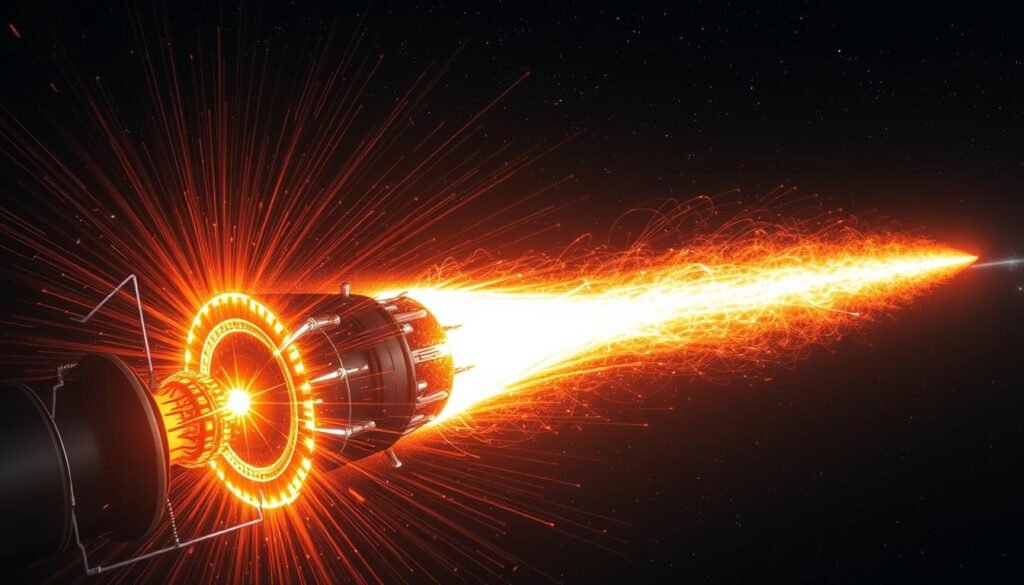
Newton’s Second Law states that force equals mass times acceleration (f = ma). This equation reveals how the same force produces different results depending on the object’s mass.
Consider a cannon firing a cannonball. The explosion creates equal force on both objects. The heavy cannon moves slightly while the light cannonball flies far. This demonstrates how mass affects acceleration.
In rocket systems, expelled gas replaces the cannonball’s role. The rocket itself acts as the cannon. Engine pressure provides the force that accelerates gas downward and the vehicle upward.
The amount of thrust generated depends on two factors. More fuel burned per second increases the gas mass. Faster exhaust velocity boosts the acceleration component. Both maximize the final thrust.
Chemical energy converts to kinetic energy through combustion. This creates the necessary force to overcome the vehicle’s mass. Understanding this relationship is essential for efficient rocket design.
From Ground to Space: Launch Dynamics
The transition from terrestrial launch to orbital flight involves complex interactions between propulsion, gravity, and atmospheric conditions. This critical phase determines whether a mission reaches its intended destination or falls short.
The Role of Gravity and Atmospheric Drag
On the launch pad, a delicate balance of forces exists. Earth’s gravity pulls downward while the pad provides upward support. Engine ignition creates the thrust needed to overcome this equilibrium.
Atmospheric air presents another challenge during ascent. Exhaust gases must push against surrounding air, consuming valuable energy. This back-pressure reduces engine efficiency until the vehicle clears the atmosphere.
In space’s vacuum, exhaust flows freely without resistance. This allows maximum thrust utilization for achieving orbital speed. The absence of atmospheric drag enables more efficient propulsion.
Gravity constantly opposes upward motion throughout the flight. Sustained thrust is essential to overcome Earth’s pull. Vehicles must reach approximately 7,800 m/s to achieve stable orbit.
Launch pads provide crucial stability during ignition’s critical seconds. They support the massive weight until thrust becomes sufficient for liftoff. This stable foundation ensures a controlled transition into flight.
The Role of Mass and Acceleration in Flight
Flight dynamics reveal a fascinating physical transformation as a vehicle ascends. The total mass includes the structure, engines, payload, and a vast quantity of fuel.
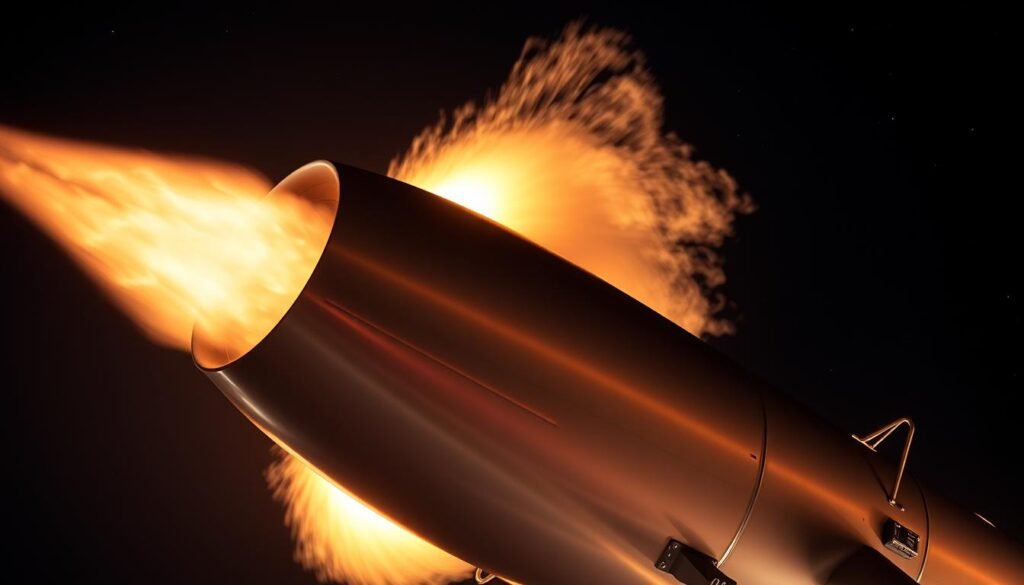
Propellants represent the largest portion of the initial mass. As engines consume this material, the vehicle becomes progressively lighter.
Understanding Fuel Burn and Mass Reduction
This constant decrease in mass directly affects the vehicle’s motion. According to Newton’s Second Law, acceleration increases when mass decreases if the thrust force remains constant.
This explains the gradual buildup of speed during flight. The vehicle starts slowly but gains velocity more rapidly over time.
This principle is fundamental to achieving orbital velocity. A deep understanding of these rocket principles is essential for mission planning. Efficient design maximizes this mass-to-acceleration relationship for successful space travel.
Historical Development and Innovations in Rocketry
Centuries before Newton’s laws provided scientific understanding, early civilizations were experimenting with primitive rocket technology. The fascinating timeline spans from ancient Chinese innovations to the modern Space Age.
Early Rocket Experiments and Medieval Roots
Gunpowder-powered devices emerged in 13th-century China under the Song dynasty. These early rockets served military and recreational purposes during that time period.
Chinese engineers developed sophisticated multiple rocket launchers. This demonstrated advanced engineering for the way warfare was conducted.
The Mongols adopted Chinese rocket technology during their invasions. This spread the invention to the Middle East and Europe by the mid-13th century.
Robert Goddard’s 1926 breakthrough revolutionized propulsion technology. He attached a supersonic nozzle to a high-pressure combustion chamber.
Goddard’s use of liquid propellants instead of gunpowder greatly reduced weight. This innovation dramatically increased the effectiveness of rocket engines.
The German V-2 rocket became the first artificial object to reach space in 1944. This represented a quantum leap in rocket technology.
The 1960s saw rapid development in both Soviet and American programs. This culminated with the 1969 Moon landing using Saturn V rockets.
Each innovation built upon previous knowledge throughout time. From gunpowder to liquid propellants, the evolution of these engines demonstrates continuous improvement.
Practical Rocketry: Building and Testing Models
Model rocket construction provides tangible insight into space vehicle design. This hands-on approach helps learners understand propulsion principles in a concrete way. Both simple hobby models and complex spacecraft share fundamental engineering concepts.
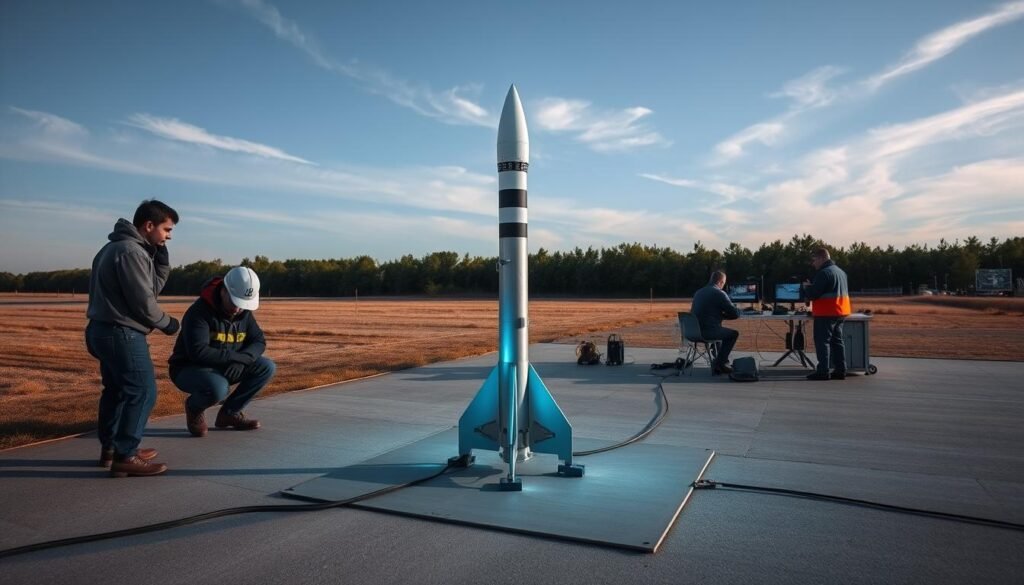
Beginners can start with commercial kits containing pre-made components. These packages introduce basic assembly terms and construction techniques. More advanced builders often create custom designs from scratch.
Safety Considerations and Testing Protocols
Chemical propulsion systems store tremendous energy in compact forms. This power requires careful handling throughout all project phases. Key safety measures include:
- Working in clear, open areas away from buildings
- Using approved ignition systems with safe distances
- Wearing protective eyewear during launches
- Checking weather conditions before flight tests
Rigorous testing procedures verify model performance before full launches. Component checks ensure proper design implementation. This systematic approach minimizes risks while maximizing learning.
Understanding these practical terms and safety protocols creates a solid foundation. This knowledge applies to all rocket projects regardless of scale. Proper preparation makes rocketry both educational and enjoyable.
Advancements in Rocket Technology and Payload Delivery
Payload delivery systems represent the cutting edge of modern space exploration capabilities. These sophisticated mechanisms ensure precise placement of spacecraft into their intended orbital paths.
Once delivered into orbital trajectories, these vehicles become artificial satellites serving numerous purposes. Commercial, scientific, and military applications all depend on reliable payload deployment systems.
Innovations in Propulsion Systems
Reusable rockets have revolutionized space access by recovering critical components. Engines and structures can now be refurbished for multiple missions.
Advanced propulsion technologies extend beyond traditional chemical systems. Ion drives and nuclear thermal engines offer efficient solutions for deep-space missions.
Modern navigation integrates satellite guidance with inertial systems for unprecedented accuracy. This ensures precise payload delivery to target orbits.
These innovations make space access more affordable and reliable. Continued advancement in propellant technology supports increasingly ambitious missions beyond Earth’s orbit.
Rocket Design Considerations for Efficient Spaceflight
Achieving orbital flight demands precise engineering solutions that balance multiple competing physical forces. Engineers must create vehicles capable of reaching incredible speed while managing limited resources.
Reaching low Earth orbit requires velocity exceeding 28,000 km per hour. Escape velocity demands over 40,250 km per hour for deep-space missions. These extreme speed requirements drive every design decision.
Optimizing Thrust and Minimizing Drag
Maximum thrust generation involves burning large fuel quantities rapidly. The engine must expel gas at highest possible speed. This creates the action force needed for acceleration.
Aerodynamic fairings reduce atmospheric resistance during ascent. Streamlined shapes minimize drag, allowing more thrust to contribute to velocity gain. Every reduction in drag improves overall efficient performance.
Balancing Fuel Efficiency and Engine Power
Additional fuel increases mass but provides longer burn duration. This balance between fuel capacity and structural weight is critical. Newton’s second law guides this optimization process.
The thrust-to-weight ratio determines launch capability. Engine power must overcome vehicle mass while maximizing efficient fuel use. Successful rocket design harmonizes these competing factors throughout the mission profile.
Each rocket represents a carefully calculated compromise. The goal remains achieving target orbit with optimal resource utilization. This delicate balance enables humanity’s continued space exploration.
Conclusion
Mastering space travel relies on fundamental physics that transform powerful equations into reality. These principles guide every launch, from combustion chamber to final orbit.
Newton’s laws provide the essential framework for propulsion. Expelled gases create thrust through action and reaction. This process overcomes gravity to achieve incredible velocity.
Chemical energy converts to kinetic force, pushing spacecraft beyond Earth’s atmosphere. The same basic equation applies whether reaching orbit or exploring deep space.
Future advancements will build upon these timeless concepts. Efficient engines and reusable designs continue to evolve over time. Our journey into the cosmos depends on this elegant science.
Understanding these mechanics reveals the brilliant simplicity behind complex spaceflight. From early experiments to modern missions, the same physical laws propel humanity forward.

